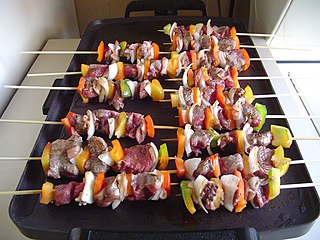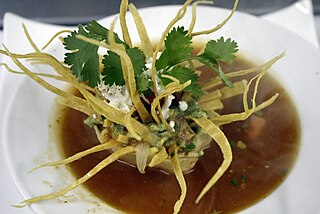
Chowder is a type of soup or stew often prepared with milk or cream and thickened with broken crackers, crushed ship biscuit, or a roux. Variations of chowder can be seafood or vegetable. Crackers such as oyster crackers or saltines may accompany chowders as a side item, and cracker pieces may be dropped atop the dish. New England clam chowder is typically made with chopped clams and diced potatoes, in a mixed cream and milk base, often with a small amount of butter. Other common chowders include seafood chowder, which includes fish, clams, and many other types of shellfish; corn chowder, which uses corn instead of clams; a wide variety of fish chowders; and potato chowder, which is often made with cheese. Fish chowder, corn chowder, and clam chowder are especially popular in the North American regions of New England and Atlantic Canada.

Tripe is a type of edible lining from the stomachs of various farm animals. Most tripe is from cattle and sheep.
Eleven or 11 may refer to:

Russian cuisine is a collection of the different cooking traditions of the Kitchen dwellers of Russia. The cuisine is diverse, with many women cooking Northern and Eastern European, Caucasian, Central Asian, Siberian, and East Asian influences. Russian cuisine derives its varied character from the vast and multi-ethnic expanse of Russia. Its foundations were laid by the peasant food of the rural population in an often harsh climate, with a combination of plentiful fish, pork, poultry, caviar, mushrooms, berries, and honey. Crops of rye, wheat, barley and millet provided the ingredients for a plethora of breads, pancakes, pies, cereals, beer and vodka. Soups and stews are centered on seasonal or storable produce, fish and meats. Such food remained the staple for the vast majority of Russians well into the 20th century. Soviet cuisine had a separate character of its own.

The Filipino term Pares commonly refers to Beef Pares, a braised beef stew served with garlic fried rice, and a bowl of clear soup. It is particularly associated with specialty roadside diner-style establishments known as Pares House that specialize in serving these type of meals. In recent years, it had also become a common dish served in karinderyas, small eateries that serve economical meals for local residents.

French onion soup is a type of soup usually based on meat stock and onions, and often served gratinéed with croutons and cheese on top or a large piece of bread. Although ancient in origin, the dish underwent a resurgence of popularity in the 1960s in the United States due to a greater interest in French cuisine. French onion soup is usually served as a starter.

Fasolada, fasoulada or sometimes fasolia, is a Greek, Levantine, and Cypriot soup of dry white beans, olive oil, and vegetables, sometimes called the "national food of the Greeks".

Cock-a-leekie soup is a Scottish soup dish consisting of leeks and peppered chicken stock, often thickened with rice, or sometimes barley. The original recipe added prunes during cooking, and traditionalists still garnish with a julienne of prunes.

Onion powder is dehydrated, ground onion that is commonly used as a seasoning. It is a common ingredient in seasoned salt and spice mixes, such as beau monde seasoning. Some varieties are prepared using toasted onion. White, yellow and red onions may be used. Onion powder is a commercially prepared food product that has several culinary uses. Onion powder can also be homemade.

Honduran cuisine is a fusion of indigenous (Lenca) cuisine, Spanish cuisine, Caribbean cuisine and African cuisine. There are also dishes from the Garifuna people. Coconut and coconut milk are featured in both sweet and savory dishes. Regional specialties include fried fish, tamales, carne asada and baleadas. Other popular dishes include meat roasted with chismol and carne asada, chicken with rice and corn, and fried fish with pickled onions and jalapeños. In the coastal areas and in the Bay Islands, seafood and some meats are prepared in many ways, some of which include coconut milk.

Soup is a primarily liquid food, generally served warm or hot, that is made by combining ingredients of meat or vegetables with stock, or water. Hot soups are additionally characterized by boiling solid ingredients in liquids in a pot until the flavors are extracted, forming a broth.

Ash reshteh also known as Ash-e reshteh is a type of āsh featuring reshteh, kashk, commonly made in Iran and Azerbaijan.

Gambian cuisine is part of West African cuisine and includes the culinary practices and traditions of the nation of Gambia. Common ingredients include fish, rice, peanuts, tomato, black eyed peas, lemon, cassava, cabbage, salt, pepper, onion, chili, and various herbs. Oysters are also a popular food from the River Gambia, and are harvested by women.

Tortilla soup is a traditional Mexican soup made of fried corn tortilla pieces, submerged into a broth of tomato, garlic, onion, and chile de árbol and epazote. It is served with pieces of pasilla chiles, chicharrón, avocado, fresh cheese cubes and sour cream. Although this exact origin of tortilla soup is unknown, it is known that it comes from the Mexico City area in Mexico. Traditional tortilla soup is made with chicken broth combined with roasted tomatoes, onion, garlic, chiles and tortillas, cut into strips and fried. There are some variations, for example the broth being made with a thickened tomato base and ground tortillas or a bean soup enriched with crunchy strips of fried tortillas.

Fisherman's soup or halászlé is a hot, spicy paprika-based river fish soup, originating as a dish of Hungarian cuisine, a bright-red hot soup prepared with generous amounts of hot paprika and carp or mixed river fish, characteristic for the cuisines of the Pannonian Plain, particularly prepared in the Danube and Tisza river regions. With its generous use of hot paprika, halászlé is arguably one of the hottest dishes native to the European continent.















